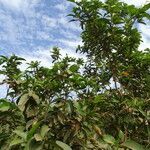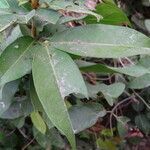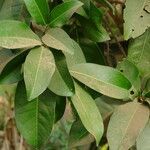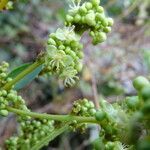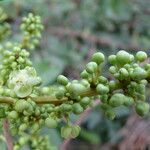Treelet or shrub, 0.5-24 m high, dbh up to 44 cm, exceptionally a liana (Peekel 1083, New Ireland); young parts densely to sparsely, appressed-ly, shortly fulvous to ferrugineous hairy. Twigs terete, 2-6 mm in diam., greyish to brown or black, smooth to verruculose by many small, orbicular lenticels. Leaves sometimes with a pseudoterminal leaflet, l-4(-6)-jugate, or sometimes (some or all leaves, in the former case either scattered among pinnate leaves or only near the inflorescence) simple; lower pair of leaflets sometimes attached near or at the base, smaller and more caducous than other ones; in vivo young leaves pinkish with reddish petioles; petiole flattened to terete, 0-14 cm long, often much swollen at base, sometimes lenticel-late like the twig; rachis terete to carinate above; petiolules terete, slightly flattened, or grooved, swollen, 2-15 cm long. Leaflets elliptic to lanceolate, widest about or below the middle, 7-35 by 2-15 cm (simple leaves up to 60 by 18 cm), charta-ceous to subcoriaceous, greyish green (rarely olive or brown) above, greyish or yellowish green to light brown beneath, densely to sparsely minutely pellucid-dotted; base acute to obtuse, more or less attenuate (in sessile simple leaves subcordate, oblique or not); apex obtuse to acuminate, mucronu-late, acumen up to 5 cm long, obtuse to acute; midrib faint to prominulous above, beneath prominent, rounded, nerves 7-20 per side, 1-3 (in the large simple leaves up to 4) cm apart, angle to midrib 30-90°, straight to curved, looped and joined at some distance from the margin, prominulous on both surfaces, between every two nerves usually 1 or 2 intercalary veins stronger developed, nerves and veins rather densely reticulate, prominulous on both surfaces, especially beneath. Inflorescences hairy to subglabrous, few to several fascicled, simple or sparsely, mostly slender branched, up to 40 cm long racemes or narrow thyrses, or sometimes a single, widely though sparsely branched, up to 60 cm long thyrse with a strong peduncle and rachis; cymes distant, short-stalked, 3-flowered; pedicels 1—4(—8) mm long. Flowers slightly fragrant, female ones apparently developing first. Sepals 5 (rarely 4), in vivo mostly dark red, concave, outer 2 oblong-ovate to orbicular, rounded at apex, 1-3 by 0.8-1.2 mm, sometimes with a narrow, peta-loid, crenulate margin, sparsely ciliolate, inner 3 up to 4 by 3 mm, mostly with a broad, petaloid, crenulate to fimbriate, ciliolate margin. Petals 5 (rarely 4), in vivo creamish or greenish white, imbricate, short-clawed to sessile, the blade elliptic to oblong, widest below to about the middle, 2.5-4.5 by 1-2 mm, entire, rounded, membranous but often thickened towards the centre and the base, ciliate at least near the base, furthermore mostly glabrous, sometimes more or less sericeous outside; scale minute to 2/5 of the length of the blade, simple to deeply bilobed (rarely divided into two minute auricles), sparsely ciliate to long-hairy (exceptionally glabrous). Disc entire (± interrupted if one of the petals is suppressed), annular to saucer-shaped Stamens 5-7(-9); filaments flattened or terete,narrowed from base to apex, 1-3.5 mm, in old flowers apparently longer than in mature ones, in vivo white, woolly in the lower ⅔, rarely sub-glabrous; anthers elliptic to ovate, 1-1.8 mm long, in vivo when young light yellow, old purplish brown., connective mostly apiculate. Ovary 2-(or 3-)lobed, 1.5-3 mm, hardly to up to 1.5 mm stipi-tate, mostly with some stiff hairs at the style base and in the basal part of the style; style cylindric, 1-2 mm long, straight to slightly curved; stigma sometimes decurrent halfway down the style, in vivo purple; pistillode often long pilose in the apical part. Fruits 2-lobed (often only 1 part developed), sessile or up to 2 mm stipitate, lobes short-ellipsoid to globular, 8-15 by 5-15 mm, smooth, when ripe in vivo dark red to black; endocarp eggshell-like, light brown. Seeds ovoid to globular, ± attenuate towards the hilum, 7-8 by 6-7 mm, testa shining, brown to black, hilum circular.
More
Monoecious evergreen tree, 6–21 m. tall with heavy crown; bark grey or pale brown, smooth; slash pale orange.. Foliage with petioles etc. and base of midribs crimson when young; leaf-rhachis 0–10 cm. long, including 0–5 cm. long petiole; petiolules 0–1 cm. long; leaflets in 1–3 pairs (sometimes reduced to 1 leaflet), the lowest pair not noticeably reduced, the upper pair opposite, drying greyish green above and paler green beneath, elliptic, 6.5–27 cm. long, 2–10 cm. wide, rounded to acuminate at the apex, cuneate at the base, entire, glabrous; secondary nerves in 12–20 pairs, ± indistinct.. Inflorescence said to be ± unpleasantly scented, often appearing terminal and accompanying a new flush of leaves, paniculate, 5–20 cm. long, 5–15 cm. wide, the branches thyrsoid with both clusters and single flowers; axes at first golden pubescent, elongating in fruit; pedicels 0–3 mm. long, enlarging to 7 mm. in fruit.. Flower greenish yellow; sepals 5, the outer 2 shorter than the inner, ovate or round, 2–3.5 mm. long, 1.5–3 mm. wide, glabrous apart from the white margin; petals 5 (rarely absent), ovate, 2–3 mm. long and wide, clawed, scale half as long as the limb, fringed with hairs; disk pentagonal, 3.6 mm. in diameter, lobed.. Stamens 5–7, hairy at base, glabrous for most of length.. Ovary 2(–3)-lobed; style entire; ovary rudiment in male flowers a cushion of hairs.. Mericarps crimson, 2(–3), developed ones ellipsoid, 1–1.8 cm. long, 0.8–1.5 cm. wide, but 1–2 abortive at base.. Seeds black, ± 1.2 cm. long, 9 mm. wide.. Fig. 17.
Trees or shrubs, evergreen, 4-6 m tall or more. Branches terete, glabrous. Leaves with petiole to 60 cm, axis strong, stout, grooved; leaflets 3-6 pairs; petiolule ca. 1 cm, stout; blades olive-green when dry, ovate or ovate-lanceolate, 15-40 × 4-14 cm, subleathery, glabrous, base rounded or sometimes nearly cuneate, margin entire, apex acuminate or shortly acuminate. Inflorescences axillary, usually shorter than leaves. Pedicels 1-2 mm. Smaller sepals broadly ovate, 1.2-2 mm; larger ones suborbicular, 2.5-3 mm in diam. Petals 5 or sometimes 4, purplish red, broadly ovate, 4-5 × 3-3.5 mm, apex rounded or subtruncate; scales ciliate. Stamens 8 or sometimes 7; filaments ca. 1.5 mm, middle part slightly inflated, villous; anthers oblong, connectives slightly prominent. Ovary obcordiform, usually 2-lobed, 2-loculed; style short, stout; stigma shallowly 2-lobed. Fruit purplish red; fertile schizocarp ellipsoid, ca. 1.6 × 0.8 cm. Fl. Feb-Mar, fr. May.
A shrub or tree. It grows 5 m tall. It can grow to 24 m high. The trunk can be 45 cm across. The branches often have small cracks along them. The bark is smooth and pale brown. The leaves are leathery. The leaves are compound. The leaves are divided 3-6 times. They are 30-60 cm long. There are 4-8 leaflets. They are 6-30 cm long by 3-10 cm wide. The lowest pair of leaflets are small and often fall off. The flowers are in groups and can be in the axils of leaves or hanging from the branches. The flowers are small and red. The flowers are 8-10 mm across. There are 4 or 5 white petals. The fruit are dark red to black berries. They are lobed. They are 2-3 cm long. There are 1 or 2 seeds. These are 14-19 mm long and grey-brown. The fruit are edible.
Pending. See Bibliography.
